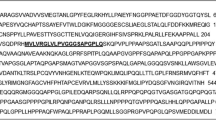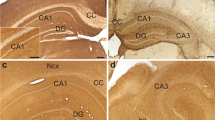Summary
We isolated three glial fibrillary acidic protein (GFAP) cDNA clones from a glioma cell line, U-251 MG. One clone isolated from a U-251 MG cDNA library was long, but lacked both ends. Using poly(A)+ RNA and primers synthesized according to the sequence of this clone, we used the polymerase chain reaction-assisted rapid amplification of cDNA ends (PCR-RACE) method, which is a strategy to isolate cDNA ends, and obtained cDNA clones for the 5′ and 3′ ends. From the sequences of these overlapping clones, the complete nucleotide sequence of human GFAP cDNA was established. The start (ATG) and the stop (TGA) signals were seen at nucleotide positions 15 and 1311, respectively, and divided the entire sequence of 3027 bp into 14 bp of 5′ non-coding, 1296 bp of coding and 1717 bp of 3′ non-coding regions. Using cDNA probes made from both the coding and the 3′ non-coding regions, Northern blot hybridization was performed with two different stringencies on RNAs from human and rodent brains and human GFAP-positive and-negative cells. It was shown that the 3′ non-coding region probe was more specific for human GFAP than the coding region probe which was specific only under higher stringency conditions. This was also suggested by homology analysis of the sequence with those of various intermediate filament proteins. Based on these findings, we performed spot blot hybridization of sorted human chromosomes and Southern blot hybridization of PCR-amplified DNAs of a panel of hamster-human somatic cell hybrids and localized the human GFAP gene to chromosome 17.
Similar content being viewed by others
References
Alberts B, Bray D, Lewis J, Raff M, Roberts K, Watson JD (1989) The cytoskelton. In: Molecular biology of the cell, 2nd edn. Garland Publishing, New York London, pp 613–680
Aviv H, Leder P (1972) Purification of biologically active globin messenger RNA by chromatography on oligothymidylic acid-cellulose. Proc Natl Acad Sci USA 69:1408–1412
Backhovens H, Gheuens J, Slegers H (1987) Expression of glial fibrillary acidic protein in rat C6 glioma relates to vimentin and is independent of cell-cell contact. J Neurochem 49:348–354
Barletta C, Batticane N, Ragusa RM, Leube R, Peschle C, Romano V (1990) Subchromosomal localization of two human cytokeratin genes (KRT 4 and KRT 15) by in situ hybridization. Cytogenet Cell Genet 54:148–150
Bernier L, Colman DR, D'Eustachio P (1988) Chromosomal locations of genes encoding 2′,3′ cyclic nucleotide 3′-phosphodiesterase and glial fibrillary acidic protein in the mouse. J Neurosci Res 20:497–504
Bignami A, Dahl D, Rueger DC (1980) Glial fibrillary acidic protein (GFA) in normal neural cells and in pathological conditions. Adv Cell Neurobiol 1:285–310
Brenner M, Lampel K, Nakatani Y, Mill J, Banner C, Mearow K, Dohadwala M, Lipsky R, Freese E (1990) Characterization of human cDNA and genomic clones for glial fibrillary acidic protein. Mol Brain Res 7:277–286
Chirgwin JM, Przybyla AE, MacDonald RJ, Rutter WJ (1979) Isolation of biologically active ribonucleic acid from sources enriched in ribonucleases. Biochemistry 18:5294–5299
Eng LF, Vanderhaeghen JJ, Bignami A, Gerstl B (1971) An acidic protein isolated from fibrous astrocytes. Brain Res 28:351–354
Eng LF, Smith ME, De Vellis J, Skoff RP (1985) Recent studies of the glial fibrillary acidic protein. Ann NY Acad Sci 455:525–537
Feinberg AP,Vogelstein B (1983) A technique for radiolabeling DNA restriction endonuclease fragments to high specific activity. Anal Biochem 132:6–13
Ferrari S, Battini R, Kaczmarek L, Rittling S, Calabretta B, de Riel JK, Philiponis V, Wei J-F, Baserga R (1986) Coding sequence and growth regulation of the human vimentin gene. Mol Cell Biol 6:3614–3620
Ferrari S, Cannizzaro LA, Battini R, Huebner K, Baserga R (1987) The gene encoding human vimentin is located on the short arm of chromosome 10. Am J Hum Genet 41:616–626
Frohman MA (1990) RACE: Rapid amplification of cDNA ends. In: Innis MA, Gelfand DH, Sninsky JJ, White TJ (eds) PCR protocols a guide to methods and applications, Academic Press, San Diego, pp 28–38
Frohman MA, Dush MK, Martin GR (1988) Rapid production of full-length cDNAs from rare transcripts: amplification using a single gene-specific oligonucleotide primer. Proc Natl Acad Sci USA 85:8998–9002
Geisler N, Weber K (1982) The amino acid sequence of chicken muscle desmin provides a common structural model for intermediate filament proteins. EMBO J 1:1649–1656
Giulian D, Young DG, Woodward J, Brown DC, Lachman LB (1988) Interleukin-1 is an astroglial growth factor in the developing brain. J Neurosci 8:709–714
Gubler U, Hoffman BJ (1983) A simple and very efficient method for generating cDNA libraries. Gene 25:263–269
Heath P, Elvin P, Jenner D, Gammack A, Morten J, Markham A (1990) Localization of a cDNA clone for human cytokeratin 18 to chromosome 17p11-p12 by in situ hybridisation. Hum Genet 85:669–670
Henikoff S (1984) Unidirectional digestion with exonuclease III creates targeted breakpoints for DNA sequencing. Gene 28:351–359
Hurst J, Flavell D, Julien J-P, Meijer D, Mushynski W, Grosveld F (1987) The human neurofilament gene (NEFL) is located on the short arm of chromosome 8. Cytogenet Cell Genet 45:30–32
Lewis SA, Balcarek JM, Krek V, Shelanski M, Cowan NJ (1984) Sequence of a cDNA clone encoding mouse glial fibrillary acidic protein: structural conservation of intermediate filaments. Proc Natl Acad Sci USA 81:2743–2746
Li Z, Lilienbaum A, Butler-Browne G, Paulin D (1989) Human desmin-coding gene: complete nucleotide sequence, characterization and regulation of expression during myogenesis and development. Gene 78:243–254
Li Z, Mattei M-G, Mattei J-F, Paulin D (1990) Assignment of the mouse desmin gene to chromosome 1 band C3. Genet Res 55:101–105
Mattei M-G, Dautigny A, Pham-Dinh D, Passage E, Mattei J-F, Jolles P (1988) The gene encoding the large human neurofilament subunit (NF-H) maps to the q121-q131 region on human chromosome 22. Hum Genet 80:293–295
Maxam AM, Gilbert W (1977) A new method for sequencing DNA. Proc Natl Acad Sci USA 74:560–564
Minoshima S, Kawasaki K, Fukuyama R, Maekawa M, Kudoh J, Shimizu N (1990) Isolation of giant DNA fragments from flow-sorted human chromosomes. Cytometry 11:539–546
Miura M, Tamura T, Mikoshiba K (1990) Cell-specific expression of the mouse glial fibrillary acidic protein gene: identification of the cis- and trans-acting promoter elements for astrocyte-specific expression. J Neurochem 55:1180–1188
Morrison RS, De Vellis J, Lee YL, Bradshaw RA, Eng LF (1985) Hormones and growth factors induce the synthesis of glial fibrillary acidic protein in rat brain astrocytes. J Neurosci Res 14:167–176
Nishiyama A, Onda K, Washiyama K, Kumanishi T, Kuwano R, Sakimura K, Takahashi Y (1989) Differential expression of glial fibrillary acidic protein in human glioma cell lines. Acta Neuropathol 78:9–15
Norenberg MD, Neary JT, Norenberg L-OB, McCarthy M (1990) Ammonia induced decrease in glial fibrillary acidic protein in cultured astrocytes. J Neuropathol Exp Neurol 49:399–405
O'Callaghan JP, Brinton RE, McEwen BS (1989) Glucocorticoids regulate the concentration of glial fibrillary acidic protein throughout the brain. Brain Res 494:159–161
Osborn M, Weber K (1983) Tumor diagnosis by intermediate filament typing: a novel tool for surgical pathology. Lab Invest 48:372–394
Ponten J, Westermark B (1978) Properties of human malignant glioma cells in vitro. Med Biol 56:184–193
Quax W, Khan PM, Quax-Jeuken Y, Bloemendal H (1985) The human desmin and vimentin genes are located on different chromosomes. Gene 38:189–196
Rataboul P, Biguet NF, Vernier P, De Vitry F, Boularand S, Privat A, Mallet J (1988) Identification of a human glial fibrillary acidic protein cDNA: a tool for the molecular analysis of reactive gliosis in the mammalian central nervous system. J Neurosci Res 20:165–175
Reeves SA, Helman LJ, Allison A, Israel MA (1989) Molecular cloning and primary structure of human glial fibrillary acidic protein. Proc Natl Acad Sci USA 86:5178–5182
Sambrook J, Fritsch EF, Maniatis T (1989) Molecular cloning, a laboratory manual, 2nd edn. Cold Spring Harbor Laboratory Press, New York
Sanger F, Nicklen S, Coulson AR (1977) DNA sequencing with chain-terminating inhibitors. Proc Natl Acad Sci USA 74:5463–5467
Southern EM (1975) Detection of specific sequences among DNA fragments separated by gel electrophoresis. J Mol Biol 98:503–517
Takahashi Y (1992) Gene expression in the cells of the central nervous system. Prog Neurobiol 38 (in press)
Takeshita I, Sawa H, Nakamura T, Kuramitsu M, Kitamura K, Fukui M (1990) Contrary effect of lactic acid on expression of neuron-specific enolase and glial fibrillary acidic protein in human glioma cells. Acta Neuropathol 79:506–512
Thomas PS (1980) Hybridization of denatured RNA and small DNA fragments transferred to nitrocellulose. Proc Natl Acad Sci USA 77:5201–5205
Yanisch-Perron C, Vieira J, Messing J (1985) Improved M 13 phage cloning vectors and host strains: nucleotide sequences of the M 13 mp18 and pUC19 vectors. Gene 33:103–119
Author information
Authors and Affiliations
Rights and permissions
About this article
Cite this article
Kumanishi, T., Usui, H., Ichikawa, T. et al. Human glial fibrillary acidic protein (GFAP): molecular cloning of the complete cDNA sequence and chromosomal localization (chromosome 17) of the GFAP gene. Acta Neuropathol 83, 569–578 (1992). https://doi.org/10.1007/BF00299404
Received:
Revised:
Accepted:
Issue Date:
DOI: https://doi.org/10.1007/BF00299404




